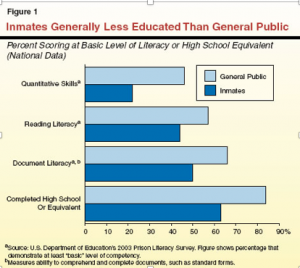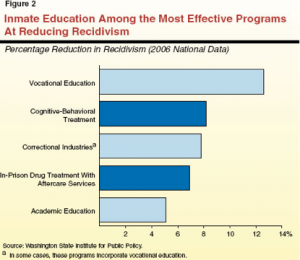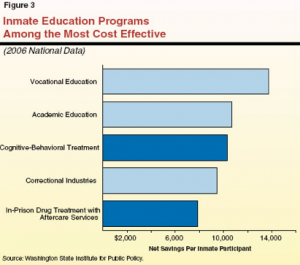 The first two employment posts focused on how to improve outcomes for reintegrating people once they were in the community. For this post, I’d like to focus on what should be happening on the inside. This is a graphic story…
The first two employment posts focused on how to improve outcomes for reintegrating people once they were in the community. For this post, I’d like to focus on what should be happening on the inside. This is a graphic story…


These graphs, excerpted from a 2008 Report to the California Legislature, largely speak for themselves. In a nutshell, inmates are under-educated and do better upon release if they receive educational programming while in prison (particularly vocational education). Put another way, prison educational programs can potentially save lots of money (and lower crime and new victimization in our communities).
The 2008 Report then goes on to make a series of recommendations to first improve, and then expand, California’s prison education programs. Not surprising the recommendations include a lot of the ‘usual suspects’:
- Programs should be evidenced-based and cost effective
- Programs (and the program staff) should be evaluated for upholding fidelity to the evidence-based model.
- Risk-Need-Responsivity Assessments of inmates should be used to ensure that programming targets the highest risk population.
- Prison facility program capacities should adequately meet the needs of their medium to high-risk inmates; if necessary, the state should reallocate program resources across facilities to meet the needs of the specific prison populations.
- “Population Movement” (which correctional facility they are housed in) should be decided, in part, by the need to connect inmates with programming.
- Program attendance, not enrollment (which deceptively inflates program utilization) should be measured to track resource allocation and utilization.
- Prison facilities should look for ways to allow for program participation during ‘lock-downs’ (when inmates are required to remain in the cells).
- Prisons should use incentives to encourage program participation.
- Vocational training should be focused on preparing inmates for skills that are in demand on the ‘outside’.
The story, however, doesn’t end there.
In 2015, California nearly doubled the amount of programming offered in the facilities. This also came at a time of significant reductions in the state’s prison population (nearly 30% below the high in 2007; largely due to sentencing and supervision changes). The goal with this increased funding was to address recommendation #3 and #4 (above).
In 2017, the California Report on facility programming. The Report, which studied utilization and effectiveness, issued a series of recommendations which were…nearly identical to the recommendations from the 2009 Report.
Ten years on–with more resources and fewer inmates–California corrections is still trying to get its educational programming right. Which serves as a segue to my next post: “We know what we should be doing but we’re not doing it…why?”
Stay tuned.